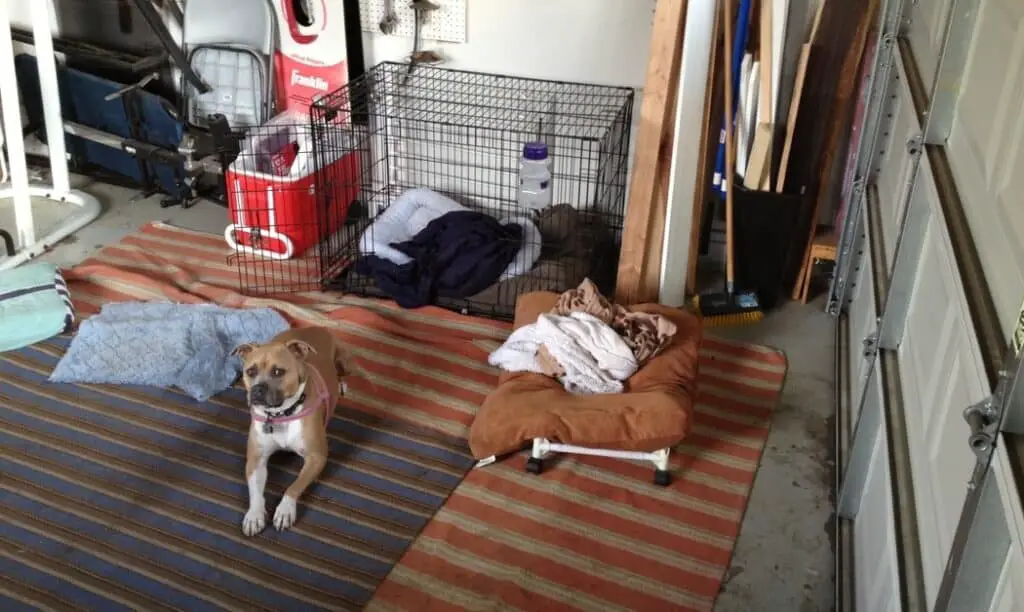Dogs are known to be pretty hardy physically as well as exceptionally adaptable, do many dog owners, especially of larger breed dogs may consider housing the family pet in the garage as opposed to a less roomy doghouse.
Depending on your climate, you may feel that you are providing your dog a safer haven from extreme temperatures both warm and cold, but that may not be the case. While a garage may seem like a fine alternative, it’s not necessarily appropriate in extreme weather.

What’s Best for My Pooch?
Some dog owners look at their fur babies as members of the family and keep their dogs directly in the house. Other pet parents feel that canines should be living outside with a doghouse for refuge, while still others may opt for a little of both.
Ideally, a dog needs and deserves what a home can offer in terms of temperature. When dogs are left outside to fend for themselves in the heat and cold, this can be the cause of health problems.
Excessive heat may lead to heat stroke or serious dehydration. Cold winter weather can cause frostbite or hypothermia.
So, in this framework, a garage may seem like the answer to a cold climate, but is it really?
The Garage as a Doghouse
Garages can expose your pooch to the same difficult climate as outdoors. Just because there are four walls, and a roof does not mean that your pooch will be adequately protected.
Most home garages do not benefit from temperature control. As a result, in the summer, the garage may be hot and stuffy with little air circulation, very similar to being closed in a hot car or truck.
In winter, if there is ice or snow outside the garage and liquids can freeze within your garage, then your dog is at risk without specific bedding to compensate for the extremely cold, below-freezing temperatures.
Pooch Is Communicating Discomfort
Your dog will communicate many things through body language as well as vocally. If your dog cries, barks, or whines continuously when closed in a garage, there is a problem. Ears and tail lowered can signal discomfort as can your dog averting your gaze.
Is It Too Cold in the Garage?
Dogs are subject to frostbite and hypothermia when exposed for too long to extreme cold. Unfortunately, many garages have the same rugged temperatures as the outdoors.
During winter, the interior temperature of the garage should not dip much lower than 50°Fahrenheit for your dog’s comfort.
Garages with proper insulation will aid in maintaining a comfortable temperature whether in cold or heat. If you are unable to use a space heater safely, provide a burrow bed that will allow your pooch to maintain its body temperature without heat dissipating during cold nights.
Can My Dog Stay in the Garage During the Daytime?
If your garage offers shelter, it will always be preferable as opposed to leaving dogs outside in extreme weather.
What Temperature Is the Right Temperature?
Most dogs will manage admirably from 45°F and above. Temperatures below 45° F may cause some dogs some discomfort such as breeds that do not tolerate the cold or breeds that have difficulties in extreme temperatures regardless.
What Temperature Is Too Cold?
If temperatures in your area fall to freezing or 32°F and below, smaller canines as well as puppies, seniors, and dogs with health issues should not be left in any space that is this cold.
If temperatures fall further to 20°F, which is below freezing, the risk of hypothermia and frostbite increase dramatically.
Is My Dog Too Cold?
If your dog exhibits shaking, shivering, the tail tucked between its legs, whining, crying, barking, behavioral changes, or looks to be seeking shelter, it probably is too cold, or cold enough to cause discomfort.

Anytime temperatures fall to 32°F. bring your dog to a warmer environment.
Dogs get cold just like people do and the AVMA (American Veterinary Medical Association) warns about the risks that cold weather can cause for our pets.
Other Dangers for Dogs Living in Garages
Temperature is not the only hazard your dog faces when closed in a garage for the night, or during the day.
Dogs that are bored or just inquisitive can easily access hazardous materials that you keep stored in your garage like chemicals, paints, antifreeze, oils, and much more.
Certain liquids can be lethal when ingested in significant amounts, and some like anti-freeze, require a very small amount to do significant damage.
They can also inadvertently injure themselves with tools or machinery that you store in the garage. Tools are very dangerous.
Imagine your dog knocking over a heavy tool or piece of machinery on itself. Apart from the injury to your dog, you may also be facing repairs or replacement of expensive equipment.
If bored, they may begin to chew on things, not only causing damage but ingesting materials that can send you running to the vet’s office.
Before even considering leaving your dog in your garage, you need to assess what you store in your garage other than your car. Frustrated dogs can become destructive, chewing on car fenders and whatever else is immediately available.
The Adaptable Canine
Because canines are so incredibly adaptable, one just assumes that they will adapt to a garage with the same serenity as a yard, doghouse, or kitchen floor.
This is probably true, however, you can make your garage a safer place if this is your best option for sheltering your dog.
Garage Safety for Dogs
Ideally, you should enclose a portion of your garage and dedicate it specifically to your dog. Dangerous materials, chemicals, liquids, and objects should be far out of reach. A comfortably sized kennel or small corral can provide a less hazardous and safer space for the pooch.
If your garage is not temperature controlled with heating or air conditioning depending on your climate, you can equip the garage with a small, but safe space heater, or a fan in the hotter weather.
In this case, you need to be sure that these solutions are electrically safe and that all cords and connections are out of reach and in good condition guaranteeing the safety of your property and your beloved pet.
Ventilation and Light
Garages are not known for adequate ventilation. If your garage has a window, this can be an advantage. Also, a garage door that leads to a fenced-in area left slightly ajar can help.
A window can also let some light in for your dog. You cannot expect your dog to sit in the dark all day. If you use the garage only for your dog to sleep in, this may present less of a problem.
Your Dog’s Needs
Your dog’s needs should be your top priority. Within your garage, you will need to ensure that your dog has sufficient fresh water always on hand and the water should be in a container that cannot easily be knocked over leaving it without water for any prolonged length of time.

If you decide to feed your dog in the garage, this should also be organized adequately and on a regular schedule.
At some point, your dog will need to urinate and defecate, so regular bathroom breaks need to be organized especially for dogs left in a garage.
Your pet depends on you and should not be left to sit in or around its urine and feces. Accidents may happen but they should not become the norm.
Exercise
Dogs need daily exercise and running around a garage is not paramount to daily exercise requirements. Walks and playtime are crucial to overall health, both physical and mental.
Your canine requires a specific amount of time daily dedicated to exercise. Companion breeds may do all right with a half-hour, but most breeds need an hour a day. High-energy breeds will require more than an hour of exercise and activity daily
Socializing
Dogs are social animals and when left free, they spontaneously form packs. A dog left to his or her own devices closed up in a garage will inevitably suffer.
Dogs need companionship and they will look primarily to you to fill this need. You or your family members must spend time with your dog, otherwise, what’s the point in having one? You cannot expect a dog to be loyal and affectionate if there is no interaction.
Tips for Your Dog in the Garage
If you need to leave your dog in the garage, especially in extreme weather conditions for its safety, follow these tips to keep your pooch safe.
1.) Garages without centralized heating or cooling must be adapted to an acceptable temperature through the use of a space heater or fan, to keep your pooch comfortable.
2.) All harmful substances, materials, and potentially dangerous tools must be stored and kept out of reach of your dog.
3.) Generous amounts of fresh water must be available at all times.
4.) Food must be furnished daily.
5.) Potty breaks need to be programmed to meet your dog’s needs.
6.) Adequate time must be allotted for daily exercise.
7.) Spend time with your dog.
How Long Is It Safe for My Dog to Remain in the Garage?
Dogs can be left alone in garages for eight hours more or less for sleep. Unacclimatized garages will be a few degrees warmer than the outside, but not sufficiently warm in extreme temperatures.
The Bottom Line
Your dog depends on you and looks to you for survival resources like food, water, and social interaction. If you decide your dog needs to go in your garage, just be sure you do it right.







